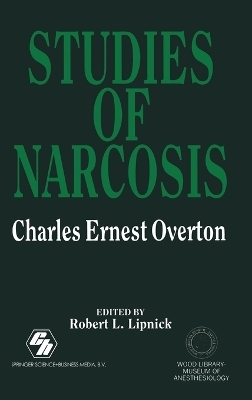
Studies of Narcosis
Chapman and Hall (Verlag)
978-0-412-35240-9 (ISBN)
This volume is an English translation of Overton's monograph on structure-activity relationships regarding anaesthetic action and toxicity. This book has been cited widely by scientists studying the correlation of biological activity with partition coefficients and the mechanism of anaesthesia. Although the original monograph was published in 1901, it should still be of value to modern toxicologists, particularly those involved in the development of quantitative structure-toxicity relationships and the predictive limitations of such models. Introductory chapters by Lipnick, Miller and Winter emphasize the importance of this text. This book should be of interest to anaesthetists, pharmacologists, toxicologists, medical and organic chemists and pharmaceutical historians.
Part 1 Studies of narcosis and a contribution to general pharmacology. Part 2 Introduction - attempts to distinguish between anaesthetics and narcotics, inhalation anaesthetics and other non-specific narcotics, non-specific and basic narcotics, factors to be considered in developing a theory of narcosis, quantitative ratios for the administration of a narcotic, calculation of the concentration of a toxicant in the blood plasma, conditions affecting blood plasma toxicant concentration, Bert's method for maintaining a constant concentration of an anaesthetic in the blood, Bert's experiments with chloroform and ethyl ether, concentration of an anaesthetic in the blood plasma, the intercellular lymph as a pathway between the blood and the tissue cells, three groups of compounds differing with respect to their permeability to tissue cells, method of producing known and constant concentrations of non-volatile compounds in the blood - limits of applicability; critical review of the major hypotheses on the mechanism of narcosis - hypotheses based on circulation in the brain, hypothesis of Claude Bernard, hypothesis of Binz, hypothesis of Dubois, Richet's principle, hypotheses based upon the chemical composition of the brain, theory of H.Meyer and the author on narcosis induced by non-specific drugs; lipoid theory of narcosis and partition coefficients - theory of partition coefficients, methods for measuring partition coefficients; heneral foundation of the lipoid theory of narcosis. Part 3 Experimental results: narcosis induced by ether and chloroform; aliphatic non-electrolyte organic compounds and narcosis - monohydric alcohols, aliphatic hydrocarbons and their halogen derivatives, nitriles and nitroethanes (nitro-paraffins), monovalent aldehydes, paraldehyde, chloral hydrate and chloral formamide, ketones, sulfones, aldoximes and ketoximes, esters of mineral acids, esters of organic acids, dihydric and polyhydric alcohols and some of their derivatives, chloralose; aromatic compounds - aromatic hydrocarbons and azobenzene, phenols and their ethers, vanillin and piperonal, oil of turpentine camphor and volatile oils, lactones and anhydrides, acetoanilide, methacetin and phenacetin, additive effects of two or more non-specific narcotics; inorganic anaesthetics - carbon dioxide, carbon disulphide, nitrous oxide; action of basic narcotics and basic compounds - classification of the basic organic compounds according to their degree of alkalinity, formation of salts with cell proteins, action of some very weak organic bases, action of some stronger organic bases, similarities and differences in the action of non-specific narcotics and organic bases, complexes of organic bases with tannins and proteins, relationship between the constitution of organic base and its physiological effects.
| Einführung | Keith W. Miller, Peter M. Winter, Leonard L. Firestone |
|---|---|
| Zusatzinfo | chemical index, index |
| Verlagsort | London |
| Sprache | englisch |
| Maße | 156 x 234 mm |
| Gewicht | 620 g |
| Einbandart | gebunden |
| Themenwelt | Medizin / Pharmazie ► Medizinische Fachgebiete ► Pharmakologie / Pharmakotherapie |
| Medizin / Pharmazie ► Pharmazie | |
| ISBN-10 | 0-412-35240-0 / 0412352400 |
| ISBN-13 | 978-0-412-35240-9 / 9780412352409 |
| Zustand | Neuware |
| Haben Sie eine Frage zum Produkt? |
aus dem Bereich


